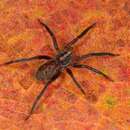en
names in breadcrumbs


The spider family Miturgidae (prowling spiders) includes 371 described species (Platnick 2013). A dozen of these species occur in North America north of Mexico; of these, Cheiracanthium is widepread, Strotarchus piscatorius occurs along the east coast, and the other species are southern (Ubick and Richman 2005).
Miturgids are wandering hunters found in forests, scrub, and rocky deserts. Most are ground dwellers and are found under rocks and plant detritus. Some species may fuel their active lifestyles by supplementing their diets with nectar (Taylor and Pfannenstiel 2008). The life cycle of one of the best know miturgids, Cheiracanthium inclusum, was studied by Peck and Whitcomb (1970). This species can be common in some agricultural crops (where it may be beneficial to farmers by consuming caterpillars and other pest insects). It is also common in houses, where it constructs white sac-like retreats, which may vary in form depending on whether they are to be used for resting, molting, mating, breeding, or hibernating. Despite some claims to the contrary, Cheiracanthium bites are apparently no worse than a bee or wasp sting (Fasan et al. 2008; Vetter and Isbister 2008), although in at least some cases symptoms may be quite unpleasant (e.g., Papini 2012).
Many of the species currently placed in the family Miturgidae were formerly included within Clubionidae (a placement some recent authors have also endorsed) and share with clubionids conical spinnerets, claw tufts, and the construction of silk retreats. Like spiders in many other families, a miturgid's eight eyes are arranged in two rows of four. The taxonomic history of this group was reviewed by Ubick and Richman (2005).
(Ubick and Richman 2005 and references therein; Bradley 2013)
Miturgidae is a family of araneomorph spiders that includes nearly 170 species in 29 genera worldwide.[1] First described by Eugène Simon in 1886,[2] it has been substantially revised, and includes the previous family Zoridae as a synonym,[3] and excludes the family Xenoctenidae.[4] Several genera have also been removed, such as the large genus Cheiracanthium, which was transferred to the Cheiracanthiidae.[5]
As of April 2019, the World Spider Catalog accepts the following genera:[1]
Miturgidae is a family of araneomorph spiders that includes nearly 170 species in 29 genera worldwide. First described by Eugène Simon in 1886, it has been substantially revised, and includes the previous family Zoridae as a synonym, and excludes the family Xenoctenidae. Several genera have also been removed, such as the large genus Cheiracanthium, which was transferred to the Cheiracanthiidae.